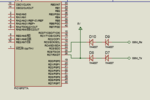Ngoroka
Junior Member level 1
I had designed a project that involves the serial communication between GSM and PIC. But I faced the problem of communication, Initially I used MAX232 to change the level of voltage from 5V of PIC to 3v of GSM but nothing detected from pic to GSM and vice versa, I tried to connect directly without MAX232 but still the problem persisted, then I decided to checkup using Hyperterminal, Both PIC and GSM seems to be okay and communicated fine with PC using FTDI breakout board. so what is wrong with this interfacing.


